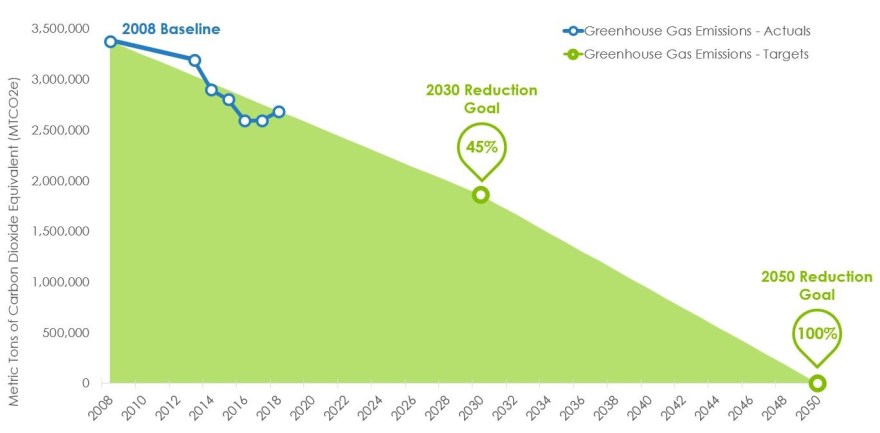Though rain was falling, spirits were high at Broad Rock Community Garden in Southside Richmond on Friday morning, where city leaders and community members celebrated the approval of a long-developing climate action plan.
City Council adopted the RVAGreen2050: Climate Action Equity Plan 2030 on Monday, resolving to reduce Richmond’s total greenhouse gas emissions 45% by 2030 — and reach net zero emissions by 2050 — while ensuring equity throughout the city’s neighborhoods.
The plan was promised by Mayor Levar Stoney when he was inaugurated in 2017. The process took a long time — “I was a lot younger, had less gray hair,” — but it was worth it to make sure the plan considered the needs of the city’s diverse population, he said at the community garden on Friday.
“Not only will we create a better community for everyone, but we will be able to right the wrongs, right the injustices in our past,” Stoney said.
Along the way, City Council signed a climate emergency resolution, in which members resolved to a just and equitable transition to net-zero emissions.
Stoney gave especially high praise to members of the racial equity and climate justice roundtable, a broad group of stakeholders who helped guide the city’s extensive public outreach effort.
Pathways
The plan is split into five pathways based on the working groups’ ranked evaluations, which are each further divided into objectives, strategies, potential emissions impacts and quality of life changes for Richmonders — as well as barriers to their implementation:
- Buildings and energy
- Community
- Environment
- Transportation and mobility
- Waste reduction and recovery
Strategies include incentivizing solar panel installations, developing a clean energy workforce, building resilient and energy efficient affordable housing, establishing grant funds, improving walking, biking and public transit infrastructure, and continued engagement with the city’s front-line communities bearing the brunt of heat, flooding, air pollution and more.
In Richmond, front-line communities are largely identified by the city’s Climate Equity Index, a mapping tool illustrating climate-vulnerable parts of the city.
Some of the work is already underway. Richmond is in the process of hiring an urban forester and updating its forestry master plan. The city also recently stood up a pilot composting program and has been building relationships with community members throughout the RVAGreen2050 planning process.
And according to inventories created by the Office of Sustainability, Richmond’s yearly emissions fell 21% between 2008 and 2018, giving the city a head start on its goal of 45% reduction by 2030. Still, total emissions did increase in 2018, and there’s no data for following years due to a lack of funding for assessments.
Laura Thomas, director of Richmond’s Office of Sustainability, said the city is in the process of hiring an energy program manager who will be responsible for updating the greenhouse gas inventory.
Stoney also reiterated his goal of purchasing 50% of city government’s energy from renewable sources by the end of this year — and promised news on that front soon.

Implementation
“Now that the plan has been adopted, the most difficult and most important work begins: implementation,” Stoney said.
It’s not clear exactly how much money the city will need to spend to carry out the plan’s goals, but it will be expensive to manage the wide range of infrastructure projects.
To that end, 26 local and mostly conservation-minded organizations have signed on to a list of policy and budget recommendations for City Council and the mayor to consider.
They’re calling for a range of investments in housing, infrastructure, transportation and economic development.
Elle De La Cancela is a campaign coordinator at the Chesapeake Climate Action Network, which signed on to the recommendations. She said the city needs to do more and do it faster to protect residents from the impacts of climate change — but added the Climate Action Equity Plan 2030 is a start, “in a huge way.”
“We’ll have to see come budget season what City Council takes of those and actually moves forward on,” De La Cancela said.
She said the recommendations are intended as guidance as Stoney’s office prepares to submit a budget proposal next month.
The listed suggestions are almost as broad as the equity action plan itself: installing energy efficiency upgrades on city facilities, funding the Office of Sustainability so it can fully carry out oversight of the plan’s progress and continuing to fund GRTC’s free fare program are all included.
Thomas said one of her office’s main projects throughout the implementation period is funding focused: helping local organizations identify and win a slew of federal grants set to come out over the next several years.
“Overall, there’s about $586 billion — with a B — federal dollars geared towards climate action,” Thomas said. The office’s responsibility will be to identify “shovel-ready” projects that can quickly apply for grant funding.
Those projects could cover everything from wastewater system improvements to equity-minded greening projects, like the Broad Rock garden. They will be largely planned and executed by local groups like GroundworkRVA, Happily Natural Day and Southside ReLEAF.
Ending his speech, Stoney said Richmonders need to be committed to the plan’s goals — and not just for themselves.
“The onus is on us to ensure that our grandchildren and our great grandchildren have access to this beautiful land that we have,” Stoney said.



